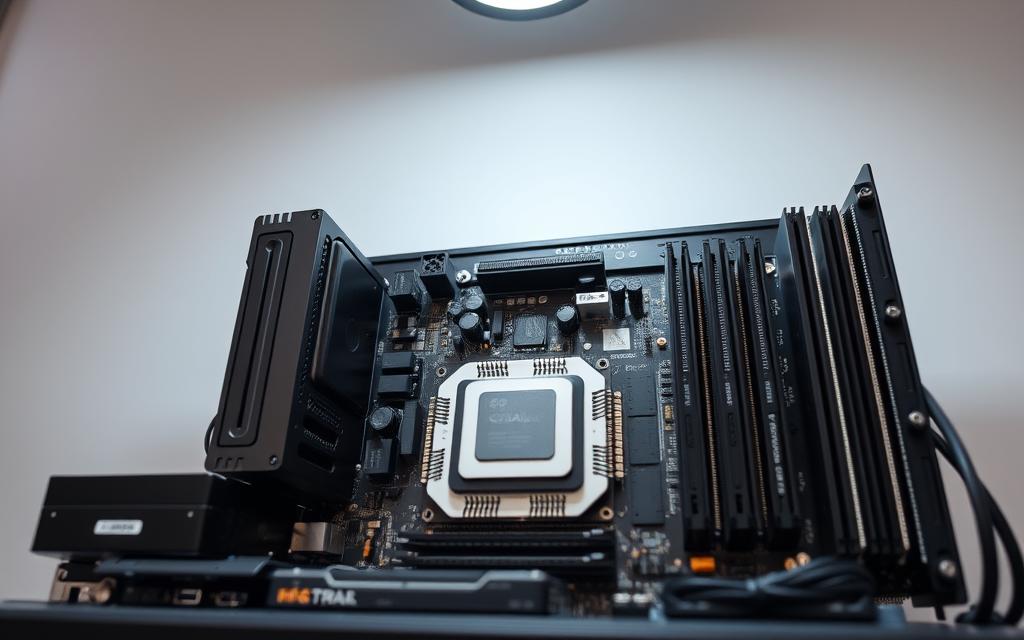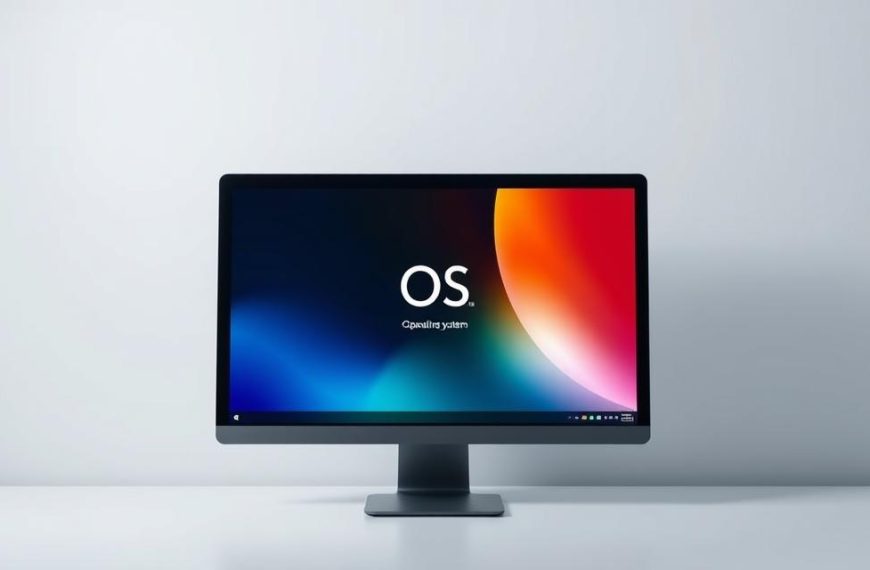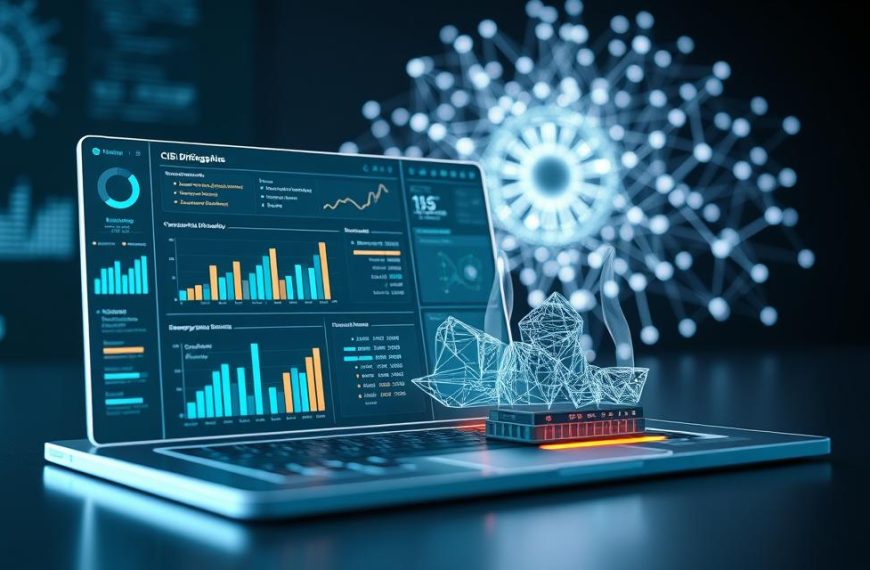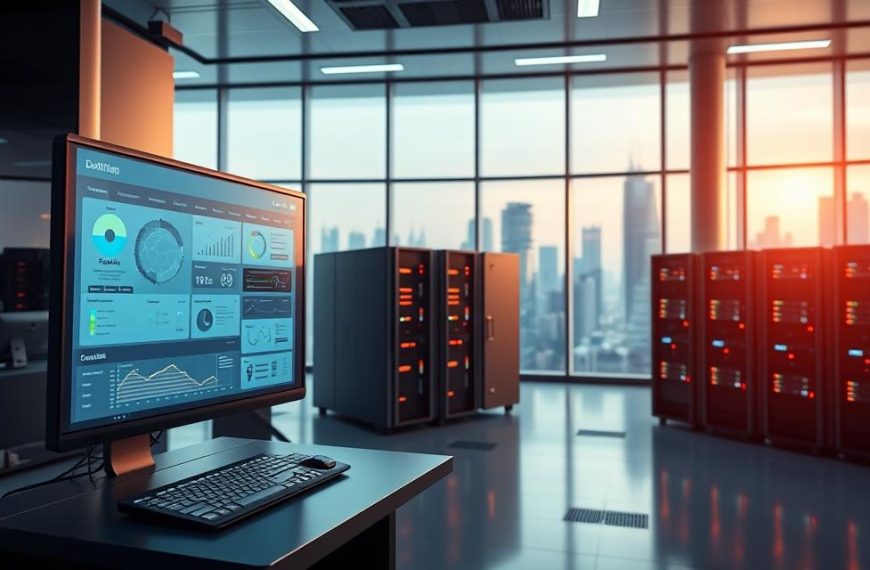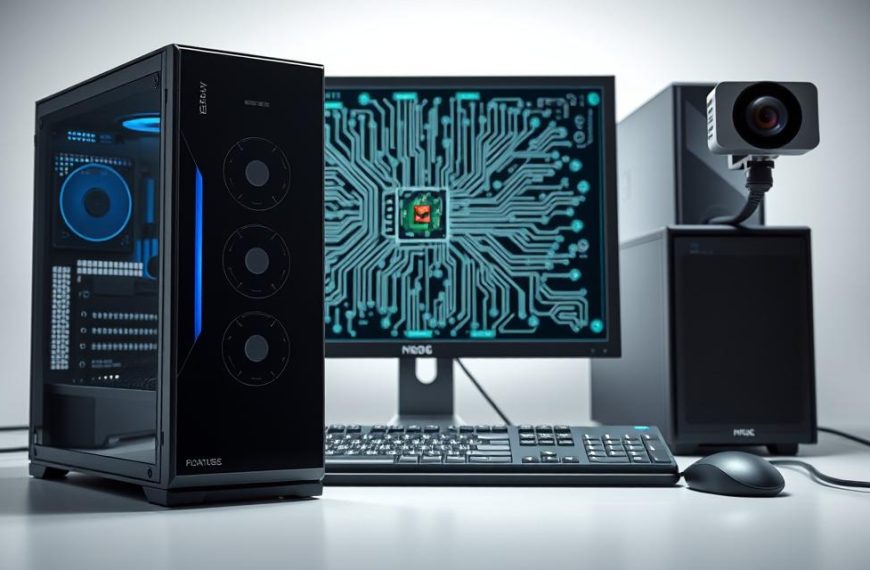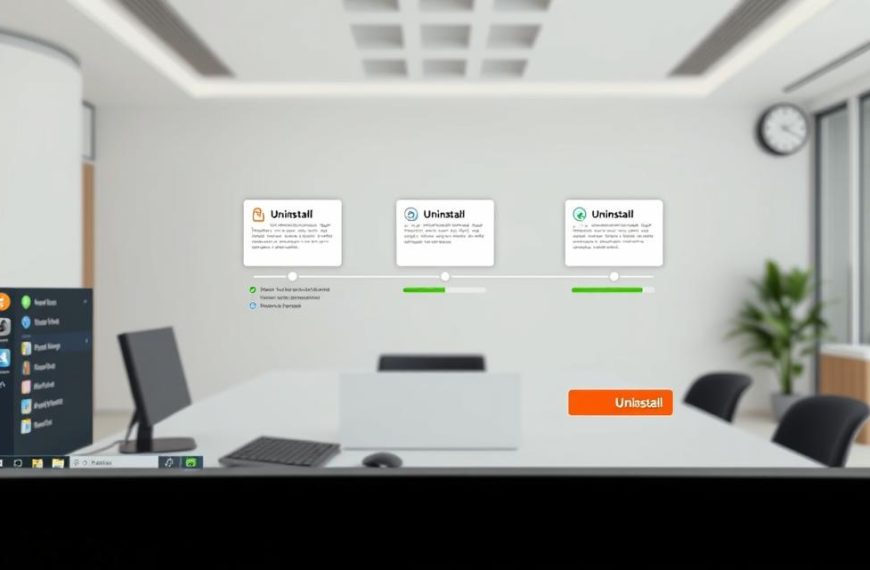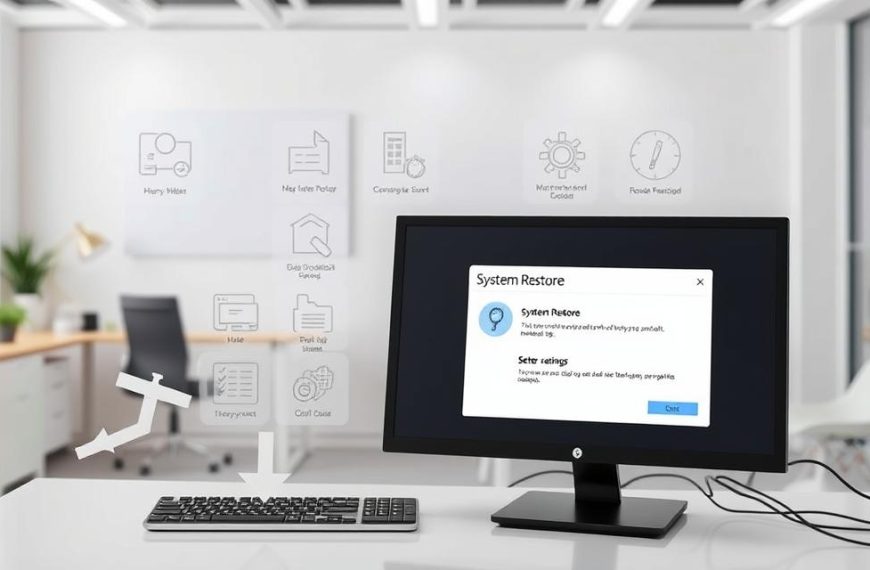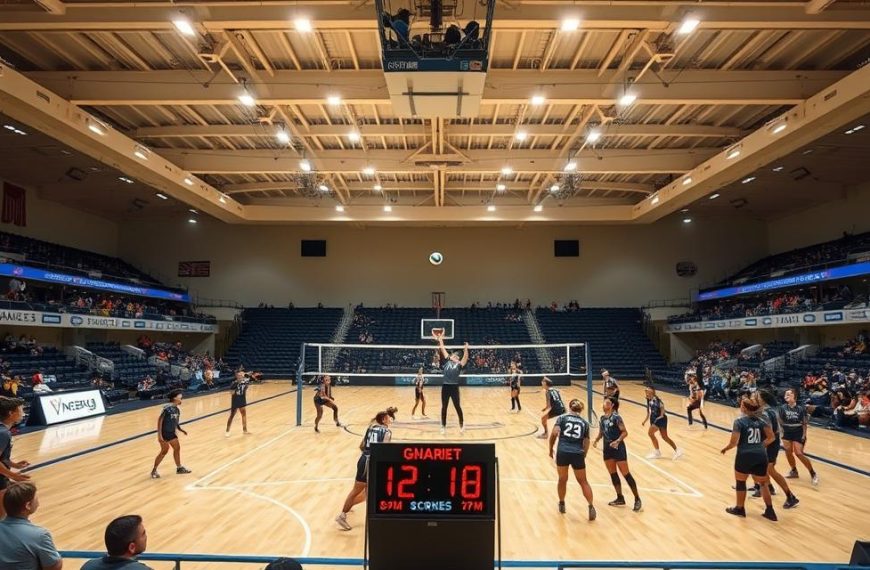Modern computing is a complex mix of parts working together. It’s not just one device but a whole system. This system has many core computer parts that work together to handle information and tasks.
Knowing about these fundamental computer elements helps us understand how technology works. It shows how different parts come together to make computing possible.
The computer system components are hardware, software, data, and the user. Each part is important for a computer to work well.
Learning about these basics helps us see how technology improves and systems are designed. We’ll look at each part in more detail in the following sections.
The Fundamentals of Computer Systems
Learning about computing basics starts with understanding how parts work together. At the centre of every computer is its architecture. This blueprint shows how all parts talk to each other.
Computer architecture sets the rules for how hardware and software work together. It tells the Central Processing Unit (CPU) how to talk to memory, storage, and devices. This ensures everything works together smoothly.
The architecture is like a translator between the computer’s parts and the code it runs. It lets the CPU do its job while memory holds data temporarily. Storage devices keep information safe for a long time, and devices let users interact.
This way of system interaction turns separate parts into a working whole. The architecture makes sure they all work together to process information and follow commands. Without it, computers would just be a bunch of parts.
There are many computer architectures for different needs. Some focus on speed, while others save energy. The type of architecture used affects how well a system works.
| Architecture Component | Primary Function | Interaction Role |
|---|---|---|
| Instruction Set | Defines executable commands | CPU-to-software bridge |
| Memory Hierarchy | Manages data storage levels | Speed optimisation system |
| Bus System | Handles component communication | Data transfer pathway |
| I/O Interface | Manages peripheral devices | User interaction enabler |
Computer architecture keeps getting better with new technology. But the basic ideas stay the same in all systems. Knowing these basics helps us understand how all computers work, from phones to huge servers.
The beauty of computer architecture is how it makes complex things work together. It lets different parts do their jobs well, making computers efficient and precise. This foundation is key to modern computing, used in many devices and apps.
What Are the 4 Parts of a Computer System
Modern computing is a complex mix of four key elements: hardware, software, data, and the user. These four main computer parts make up the whole system we use today. Each part has its own role but they all need each other to work well.
The Interdependence of Core Components
Computer systems work together to achieve amazing things. The hardware is the physical base, including processors and storage. Without it, computers can’t do anything.
Software is the brain of the system. It tells the hardware what to do and how to do it. This includes everything from operating systems to apps.
Data is the heart of the system, the information being worked on. This can be anything from text to videos. The software handles this data, and the hardware makes it possible to store and process it.
The user is the final piece of the puzzle. They interact with the system, giving it input and using its output. The user decides what the system does and how it uses the data.
This creates a cycle of interaction. The user uses hardware to run software that works on data. This cycle is essential for the system to function.
For example, writing a document. The user types on a keyboard (hardware), which runs word processing software. This software manages the text data, showing it on a monitor (hardware). Each part is needed for the task to be done.
This shows why all four main computer parts are important. The best hardware is useless without the right software. And the most advanced programs need the right hardware to work.
Without purpose, data is just information. And systems without a human to guide them lack direction. The true power of computing comes when all parts work together.
Hardware: The Tangible Components
Computer hardware is the physical base of any computer. You can touch and see these parts. They work together to do digital tasks. Knowing about these parts is key to understanding how computers work.
Primary Hardware Elements and Their Functions
The main parts work together to process information. Each part has its own job in the system.
The motherboard is like the brain, connecting all parts. It lets different parts talk to each other. The motherboard role is to manage data and power.
The CPU (Central Processing Unit) is at the heart. It runs instructions from software. It does math and logical tasks fast.
RAM (Random Access Memory) holds data for tasks. It’s like a workspace for the CPU. RAM is different from storage because it’s temporary.
Storage devices like HDDs and SSDs keep data long-term. They keep information even when the computer is off.
Common Hardware Examples in Modern Systems
Today’s computers have advanced parts for specific tasks. They have special hardware for better performance.
Solid-state drives are fast. They make computers start up quicker and files load faster than old hard drives.
Dedicated graphics cards handle GPU processing for graphics. They’re key for gaming, video editing, and design.
Peripherals like keyboards, mice, and printers add to the system. They let users interact and output data.
Hardware’s Role in System Performance
The quality of parts affects how well a computer works. Better parts mean better performance.
Processor speed, measured in gigahertz, affects how fast calculations are done. Faster processors mean quicker program running and smoother multitasking.
RAM capacity, measured in gigabytes, lets more apps run at once. More RAM means better performance with demanding software.
Storage type and capacity affect how much data can be stored. Faster storage means quicker loading times.
Specialised components like GPUs improve performance in certain areas. They handle complex graphics tasks well.
| Component | Primary Function | Performance Impact | Common Specifications |
|---|---|---|---|
| CPU | Instruction processing | Overall system speed | Clock speed (GHz), cores |
| RAM | Temporary data storage | Multitasking capability | Capacity (GB), speed (MHz) |
| Storage (SSD/HDD) | Permanent data retention | Boot/load times | Capacity (GB/TB), read/write speed |
| GPU | Graphics processing | Visual performance | VRAM (GB), clock speed |
| Motherboard | Component connectivity | Expansion options | Socket type, expansion slots |
Knowing about computer hardware components helps users choose the right parts. The right mix ensures the best performance for their needs.
Software: The Programmatic Instructions
Hardware is the physical base of computing, but software gives it life. This layer of instructions turns machines into systems that can do many things. Knowing the types of software helps us understand how computers work today.
System Software vs Application Software
Computers have two main types of software: system and application. System software manages resources and is the base for other programs. It includes operating system software like Windows and macOS, which handle memory and hardware.
Application software meets specific user needs. Examples are Microsoft Excel, web browsers, and photo editors. Unlike system software, it directly interacts with users to achieve goals.
Software is changing fast, with cloud-based apps being a big change. These apps can be accessed online, not just on local computers. This makes them more flexible and requires less hardware.
Artificial intelligence is also changing software. Modern apps use AI to improve how they work and feel. Features like predictive text and image recognition are becoming common.
Security is a big focus in software trends today. Developers are adding more security features to protect against threats. This makes both system and application software safer.
Software and Hardware Integration
Software and hardware work together well. Software translates human commands into actions that hardware can do. This is done through drivers that make specific hardware work.
Every computer program turns into instructions for hardware. How well this happens affects how fast and efficient a system is. Good software can make hardware work better, while bad software can waste resources.
| Software Type | Primary Function | Examples | User Interaction Level |
|---|---|---|---|
| System Software | Manages hardware resources | Windows, macOS, device drivers | Minimal (background operation) |
| Application Software | Performs specific user tasks | Microsoft Excel, web browsers | High (direct interaction) |
| Utility Software | Maintains system performance | Antivirus, disk cleanup tools | Variable (scheduled or manual) |
| Programming Software | Creates other software | Compilers, debuggers, IDEs | Technical (developer-focused) |
Computers keep getting better thanks to advances in software. This ongoing improvement lets computers do everything from simple tasks to complex AI operations. It’s all about how software and hardware work together.
Data: The Information Lifeblood
Data is the heart of every computer system. It’s the raw information that gets turned into useful results. Without it, computers would be useless, making data essential for all digital tasks.
Types of Data and Storage Solutions
Computers deal with many types of data. Each type needs its own storage method. Text, images, audio, and instructions are just a few examples.
Storage solutions vary from quick, temporary memory to long-term archives. RAM is for fast, temporary data, while HDDs and SSDs store data longer.
For keeping data safe long-term, systems use tape backups or cloud storage. This layered approach to data storage types boosts performance and keeps data accessible.
Data Security and Management Practices
Keeping digital info safe is key. Antivirus software is the first defence against threats.
Secure printing stops unwanted access to physical documents. Encryption protects digital files. Regular backups and access controls are vital for data security management.
Good data handling means using authentication and keeping records. These steps help avoid data loss and meet rules.
Data Flow and Processing in Systems
Data moves through a system from input to output. Users or devices first provide the raw data.
The CPU then works on this data, following software rules. This data processing phase makes the data useful.
Data often moves between storage types. It goes from permanent storage to RAM for faster use during processing.
The cycle ends when systems show the processed data. This cycle is how computers work.
Knowing how data moves helps us see its value. Each step is important for computer success.
The User: The Human Operator
Hardware, software, and data are the technical parts of computing systems. But the human operator adds life to them. Users turn computers into tools for work, creativity, and talking to others.
User Interfaces and Interaction Methods
Human-computer interaction uses different interfaces to understand what we want. These interfaces have changed a lot over time.
Today, we have:
- Graphical User Interfaces (GUIs): Visual environments with icons, windows, and menus
- Command-Line Interfaces: Text-based input for precise system control
- Touchscreen Technology: Direct manipulation through gestures and taps
- Voice Recognition Systems: Speech-to-command conversion
- Haptic Feedback Devices: Physical response to user actions
Each method has its own strengths for different needs. Many systems use more than one way to interact.
User needs drive the change in technology. For example, gamers pushed for better graphics, and professionals needed special software for their work.
This cycle shows how users influence technology. It also shows how developers use user data to make systems better.
Adapting Systems to User Needs
Designing systems with users in mind is key now. It’s about making things easy to use, not hard. This means considering different abilities and preferences.
- Accessibility features for users with different physical abilities
- Customisable interface options and workflow configurations
- Adaptive systems that learn from user behaviour patterns
- Personalised software environments based on individual usage habits
This focus on user experience has changed how systems are made. The best systems work well with users, making them more effective.
Good design makes systems easier to use. It helps computers help us, not just get in the way.
Conclusion
A computer system works as a single unit. It combines hardware, software, data, and the user. This mix makes modern technology powerful in many areas of life.
Each part of the system depends on the others. Hardware does the work, software gives the instructions, data is the fuel, and the user controls it all. Knowing how these parts work together is essential.
This summary shows how vital it is for all parts to work together. Without any, the system can’t do its job well.
Learning about these basics helps users make smart choices about technology. It also shows respect for the engineering that goes into these tools.
As technology gets better, the basic ideas stay the same. Keeping these ideas in mind helps us use computers better in different situations.

